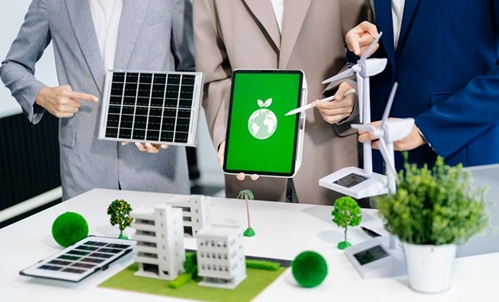(Prelims: Environmental Ecology)
(Mains, General Studies Paper- 3: Conservation, Environmental Pollution and Degradation, Environmental Impact Assessment) |

Context
Countries are currently facing the crisis of land scarcity, geopolitical conflicts, rising carbon dioxide levels and the urgency of energy self-sufficiency. As a result, there is an increasing need to adopt more renewable fuels as well as invest in smarter, more efficient and diverse energy innovation.
Need for better green technologies
Tackling climate change
- Global warming is increasing due to CO₂ emissions from the combustion of fossil fuels.
- Green technologies (solar, wind, hydrogen, battery storage) are essential for low-carbon development.
Ensuring energy equality
- According to the International Energy Agency (IEA), more than 750 million people globally do not have access to electricity.
- Green energy must be affordable and scalable to bridge energy access gaps, especially in the Global South.
Reducing dependency on critical minerals
- Current clean technologies (e.g. lithium-ion batteries) are often heavily reliant on rare minerals (lithium, cobalt, nickel). These pose geopolitical, ethical and ecological concerns.
- Alternative materials and recycling technologies are needed.
Fostering inclusive innovation
- The dominance of the Global North in clean tech innovation creates technology dependency.
- Local R&D and technology transfer are essential for equitable green transitions.
Reducing technological risks
- Current renewable energy sources are unregulated and land-intensive. Next-generation solutions such as green hydrogen, carbon capture, small modular reactors, grid-scale storage are needed.
Reducing lifecycle emissions
Green technologies (e.g. solar panels, electric vehicles) also generate carbon footprints during production and disposal. Hence, there is a need to focus on clean production technologies and circular economy.
Challenges of better green technologies
- High R&D costs and slow commercialization
- Limited international collaboration on open-source green innovations
- Patent monopolies and lack of access in the global South
Way forward
- Publicly funded research on low-cost, sustainable green technologies
- Global collaboration under frameworks such as UNFCCC, G-20 and COP
- Promote technology-transfer mechanisms, especially for developing countries
- Encourage startups and micro, small and medium enterprises (MSMEs) to innovate in green sectors
|
Also know
- India's total installed power capacity reaches 476 GW by June 2025.
- Non-fossil fuel sources now contribute 235.7 GW (49%) of total capacity.
- This includes 226.9 GW of renewable energy and 8.8 GW of nuclear power.
- Thermal power continues to be the dominant sector accounting for 240 GW or 50.52% of installed capacity.
- India has achieved 100% rural electrification by April 2018.
- According to International Renewable Energy Agency Renewable Energy Statistics, India ranks fourth globally in renewable energy installed capacity, fourth in wind power and third in solar power capacity.
|